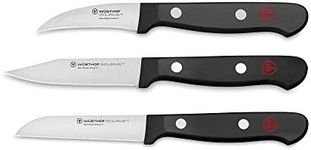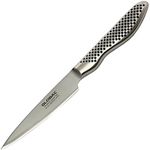Buying Guide for the Best Paring Knives
Choosing the right paring knife can make a big difference in your kitchen experience, especially for tasks that require precision like peeling, trimming, or slicing small fruits and vegetables. When shopping for a paring knife, it's important to focus on features that affect comfort, control, and durability. Understanding the key specifications will help you find a knife that feels right in your hand and suits the types of tasks you do most often.Blade LengthBlade length refers to how long the cutting part of the knife is, usually measured in inches. This is important because it affects how easy the knife is to control and what kinds of tasks it can handle. Paring knives typically range from about 2.5 to 4 inches. Shorter blades (around 2.5-3 inches) are great for very detailed work like peeling or deveining, while longer blades (closer to 4 inches) can handle slightly larger tasks like slicing small fruits. To pick the right length, think about what you’ll use the knife for most often—if you want more precision, go shorter; if you want more versatility, go a bit longer.
Blade MaterialBlade material determines how sharp the knife stays, how easy it is to maintain, and how resistant it is to rust. Common materials include stainless steel, high-carbon steel, and ceramic. Stainless steel is popular because it resists rust and is easy to care for, but may need more frequent sharpening. High-carbon steel holds a sharp edge longer but can rust if not dried properly. Ceramic blades are very sharp and don’t rust, but they can chip or break if dropped. Choose a material based on how much maintenance you’re willing to do and how careful you are with your tools.
Handle Comfort and MaterialThe handle is where you grip the knife, and its comfort and material can affect how safe and pleasant the knife is to use. Handles can be made from plastic, wood, or composite materials. Plastic and composite handles are durable and easy to clean, while wood handles can feel warmer and more traditional but may need more care. The shape and size of the handle should fit comfortably in your hand, especially if you’ll be using the knife for extended periods. Try to choose a handle that feels secure and balanced for your grip.
Blade ShapeParing knives come in a few different blade shapes, such as spear point, bird’s beak, and sheep’s foot. The shape affects how the knife moves through food and what tasks it’s best for. Spear point blades are the most common and versatile, good for general peeling and slicing. Bird’s beak blades are curved and great for peeling round fruits and vegetables. Sheep’s foot blades have a straight edge, making them good for straight cuts. Think about the types of foods you prepare most often and choose a blade shape that matches those tasks.
Weight and BalanceThe weight and balance of a paring knife affect how easy it is to control and how tired your hand gets during use. A lighter knife is easier to maneuver for delicate tasks, while a heavier knife can feel more stable for slightly tougher jobs. Balance refers to how the weight is distributed between the blade and the handle. A well-balanced knife feels comfortable and secure in your hand. To pick the right one, consider how the knife feels when you hold it—if it feels awkward or tiring, it may not be the best fit for you.


















